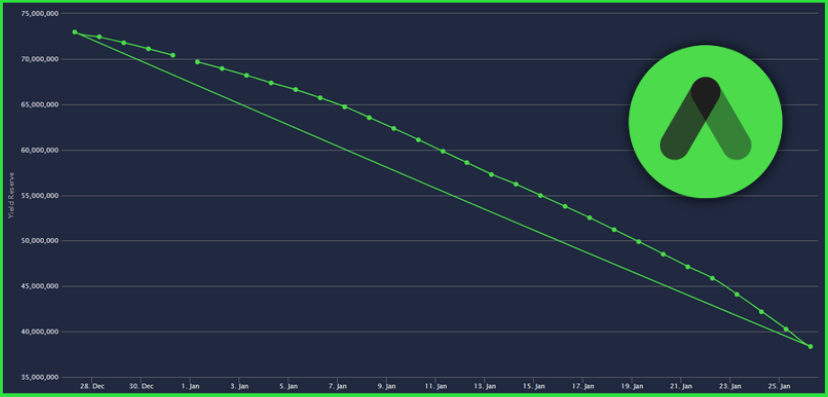Anchor Protocol Burns Through Its Reserves As Deposits Pile Up
Anchor's Yield Reserve is being depleted as deposits outpace loans.
By: Brady Dale • Loading...
DeFi
Terra’s DeFi protocol for savers is burning through its savings account.
Anchor is the DeFi protocol meant to offer a safe, predictable return for DeFi’s conservative investors. It’s widely considered the benchmark yield for the whole industry and currently sits at 19.33%.
In other words, Anchor aims to set the bare minimum yield that investors looking for a safe, boring DeFi investment should be able to expect, which is still wildly higher than anything found in the traditional market.
Ambitious Benchmark
Anchor is able to offer this high return based in part on interest paid by borrowers and in part on yield earned by those borrowers’ collateral. That said, too many savers are coming into the system and not enough loans are getting made, so Anchor has started to burn through its reserves in order to meet that ambitious benchmark. The community has noticed and started to discuss the issue.
Terraform Labs cofounder Do Kwon seems to be promising a cash infusion to shore up Anchor, but there’s no indication of where the funds would come from.
On Oct. 31, 1.9B UST had been deposited into Anchor savings and $1.1B had been borrowed.
As of yesterday, the imbalance has grown to $6.1B deposited versus $1.5B borrowed, indicating that a much smaller portion of available assets is getting deployed. UST is Terra’s dollar-pegged stablecoin.
It should come as no surprise that a safe way to earn a respectable return is popular right now.
With the market cramping up, investors who want to keep their value readily available in crypto but don’t want to risk the tumult of a market downturn, can sell their volatile crypto assets into stablecoins and stick it in a savings protocol until things become fun again. The tricky part of that equation, though, is that Anchor also relies on a healthy borrowing market to derive yield through making loans.
Setting a benchmark rate at or near 20% was always ambitious. Other entrepreneurs in the space are attempting to set simpler standards with savings products that have an easy user experience, but indicative rates are lower, in the 5-10% range.
Savers in Anchor deposit TerraUSD (UST), the most popular stablecoin on the Terra blockchain. Those deposits are lent out to borrowers, who stake proof-of-stake coins as collateral. Interest rates charged to borrowers rise in line with the demand for loans. The borrowing rate is set algorithmically by the Anchor protocol based on the amount of available UST.
Sideways Market
An environment where demand for deposits is going up but demand for loans is flat or dropping, drives the cost of loans (and the overall yield on Anchor) down.
Previously, demand for loans had been buoyant as traders borrowed money to leverage their market exposure. When the combined returns on interest and collateral yields are more than Anchor needs to meet its obligations to savers, it puts the difference into the Anchor Reserve (basically, the savings protocol’s savings account). The reserve is also funded with 1% of any liquidations that take place on loans. The reserve is meant to cover the difference if there’s not enough revenue to pay savers the committed rate.
Returns on collateral also aren’t contributing as much as they used to, with the value of proof-of-stake coins flat or going down. This diminishes the UST value of returns on bonded collateral.
According to MirrorTracker, the Anchor Reserve held $73.4M in UST on Dec. 26. On Wednesday, it had $37.9M. It’s been dropping by roughly $2M every day.
The problem is either an excess in demand for the savings product or a shortfall in demand for loans, depending how you look at it.
One source of demand for Anchor’s yield has been Abracadabra.Money, which has driven about 25% of the demand for deposits (including a deprecated strategy, which still has $167M worth of UST in it). On Nov. 3, it announced a strategy incorporating UST into its Degenbox program.
Most people who borrow money in crypto do so to fund trades or investments elsewhere. Collateralized lending allows hodlers to stick with their long term bet on a cryptocurrency they believe in, while also making a short term bet with a trade they think can work. But there will be fewer traders taking out such loans when the market is going sideways.
ANC Emissions
Terraform Labs, the company behind Anchor, has declined to comment further to The Defiant, but it has one mechanism at its disposal to attempt to stimulate more borrowing demand, other than simply falling rates.
Like most DeFi protocols, Anchor has a governance token. It’s called ANC, and Binance just listed it on Tuesday. For the first four years of Anchor’s existence, fresh ANC will be distributed to various users in order to stimulate the growth of the protocol. Of that, 400M ANC tokens have been set aside for distribution to borrowers.
When revenue falls below the target savings rate, Anchor starts boosting emissions of ANC to borrowers, in order to attract fresh demand. ANC traded at around $3.50 in early November when savings and borrowing rates started to diverge sharply. It is currently trading at $1.63, so upping emissions may actually feel much like treading water for potential borrowers.
Whatever the reason, borrowing on Anchor has remained essentially flat, so the reserve balance has continued to fall. At current rates, the reserve stands to be depleted in about 20 days if it is not topped up somehow or fresh borrowing demand doesn’t kick in.
Advertisement
Get the best of The Defiant directly in your inbox 💌
Know what matters in Web3 with The Defiant Daily newsletter, every weekday
90k+ investors informed every day. Unsubscribe anytime.